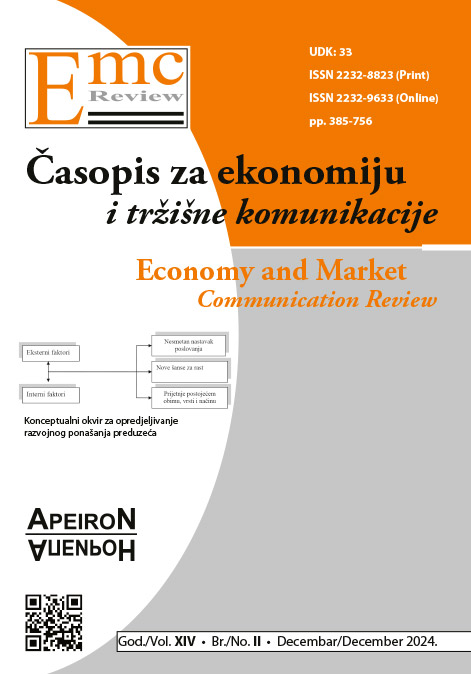DIFFERENCES IN THE FINANCIAL CYCLE OF BOSNIA AND HERZEGOVINA AND OTHER CURRENCY AREAS
DOI:
https://doi.org/10.7251/EMC2402392JKeywords:
loans, monetary policy, financial cycle, gap analysisAbstract
The financial cycle is determined based on real loans or the ratio of loans to nominal GDP. In the research, we applied the standard methodology of determining trends and cycles as deviations from the trend using the Hodrick-Prescott filter. We entered the research with two hypotheses. We assumed that the BH financial cycle is different from the financial cycle in the eurozone. We also assumed that the difference between the highest and the lowest point of the financial cycle is the most pronounced in Bosnia and Herzegovina. In addition to the financial cycle in Bosnia and Herzegovina, the subject of analysis was the financial cycle in eurozone, Slovenia, Serbia, Bulgaria, and Croatia. Measured by real loans, Bosnia and Herzegovina had two financial cycles in the past period, while the ratio of loans to GDP indicates only one financial cycle. Both methods of determining the financial cycle show that credit activity in BH in the recent period is significantly below the trend. Compared to other countries, the correlation between the BH financial cycle and that of the eurozone is relatively low. Due to the characteristics of the banking and financial market, the absence of the credit function of the central bank on the domestic market, and the generally low degree of monetary policy discretion, the recent values of the financial cycle in BH are the lowest in the selected sample of currency areas. In BH the biggest difference is shown in the final values of the financial cycle measured by real credit, and the same result is shown in the financial cycle based on financial intermediation depth. The exception is Slovenia, where the banking crisis had a long-term impact on the financial cycle. At the end of the analyzed period, BH has the lowest value of the financial cycle. For the correction of the financial cycle, BH has at its disposal the existing instruments of monetary policy, the reserve requirements, remuneration on reserve requirements, and excess reserves, and it can introduce new ones; ex nihilo issuance of primary money and macroprudential regulation. The currency board regime does not guarantee compliance of the financial cycle with the reserve currency currency area. Bosnia and Herzegovina has a financial cycle, which is significantly different from that of a country with a reserve currency. A significant deviation from the trend value of the loan-to-GDP ratio is also connected with the use of credit potential for exposure of BH banks to predominantly еurozone markets. The extremely low recent value of the BH financial cycle indicates the low level of liquidity of the BH economy. The potential ex nihilo issue of the primary money of the central bank in the BH monetary regime would be a strong corrective factor of the financial cycle in Bosnia and Herzegovina.
